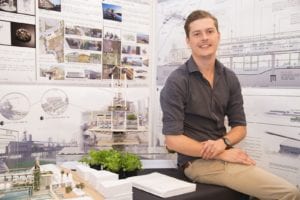
Jean-Pierre Desvaux De Marigny is the winner of the 30th Corobrik Architectural Student of the Year Awards
The Concept
His thesis, entitled ‘Design for [bio] diversity’, explored the potential of architecture for ecological conservation, proposing an environmental awareness and water research facility in the context of Springfield industrial park/ uMgeni River catchment area in Durban. Research revealed that human existence relies heavily on bio diverse ecosystems to survive, however as population increases, urbanisation and industrialisation occurs, resulting in natural areas often being exploited and degraded, most critically affecting the earth’s fresh water systems.De Marigny’s proposed architectural solution aimed to draw an analogy between the machine-dominated environment of the Springfield industrial park and the natural ecosystems found within the uMgeni River. This was achieved through the concept of viewing architecture as similar to that of a mechanical prosthetic device, so that the architecture (industrial machine) could begin to act as rather a natural life support system in the context in which it exists (ecology).
Attaching to an existing 440 m long pedestrian walkway bridge spanning the width of the river, the facility hosts minimal ecological footprint, in addition to providing direct access to the water body to ecologically filter both surface (plastics, rubbers, geo-polymers) and subsurface (human, industrial, agricultural) water pollutants that are accumulated as the watercourse passes through habited areas before reaching Durban’s coastline. As a result, both the technological and ecological solutions used allowed the architecture to act as a positive hybrid energy contributor, provide space for rehabilitation processes and is able to consistently produce and provide the public, tourists and researchers with fresh fish, vegetables, plants, seeds, flowers, biogas, fertilisers and clean water, who then have the option to relax and enjoy an organic meal, while overlooking the river, or take part in the various educational, ecotourism and research programs facilitated on site. Supervisor and lecturer, Bridget Horner, said that the highlight of the winning thesis was the location of the site and its potential vista toward to sea and into Durban. “The project impressively straddles one of Durban’s most beautiful rivers, the uMgeni River, as well as the existing pedestrian bridge. The architecture is a machine that filters dirt from the river and draws water up into its water purification plant – filtering water so that, in the process of moving over the infrastructure, the purification of water as a process is visible to the pedestrian,” she explained. She noted that the project drew its architectural language from the cranes and containers that occupied the Durban harbour. This was in keeping with the architecture’s role as a mechanised prosthetic device supporting the river in flushing out its impurities before they meet the sea.






